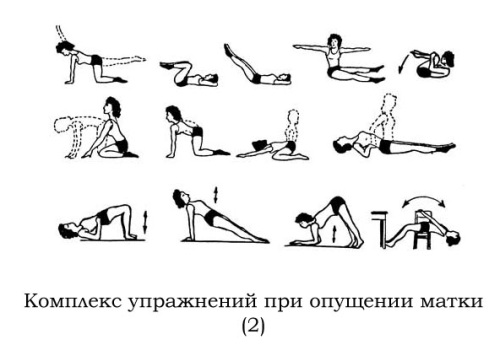This phenomenon is a fairly common pathology that occurs when the fundus or cervix is displaced. Often this disease is accompanied by weakening of the muscles or ligaments that hold the uterus in its correct anatomical position.
According to statistics, women aged 30-40 years are at increased risk. About 15% of all operations on the female reproductive system account for the elimination of this particular pathology.
It is worth noting that such omission can only be called a pathology, which occurs not only in women during the reproductive period. Sometimes prolapse begins to progress from adolescence and over time the disease only develops. After a certain period, the manifestations of pathology become more and more noticeable and often suffering leads to loss of ability to work due to the fact that every movement is accompanied by pain.
With the correct location of the uterus in the insides of the small pelvis, it has the correct location in relation to nearby organs, the muscles and ligamentous apparatus will be in good shape. However, almost any violation of the integrity or strength of the pelvic cavity, as a rule, leads to prolapse or prolapse of the uterine body.
How are prolapses of the female organ classified: cervix and uterus?
Depending on the degree and nature of the complexity of the phenomenon, the following stages of prolapse of the uterine body are presented in medicine:
- Start. The cervix and the uterine body itself descend to the level at the entrance to the vagina;
- partial loss. At this stage, we will definitely see the cervix when exiting the vagina during slight physical activity, sneezing or coughing, or when lifting some heavy objects;
- loss is incomplete. In the presented situation, when exiting the genital slit, you can see the cervix and part of the uterine body itself;
- complete loss. The uterine body and cervix emerge completely from the genital slit.
Causes of uterine prolapse
The disease, which may be accompanied by prolapse or complete loss of the uterine body, has a number of causes that contribute to this. The main ones are:
- injuries located at the location of the genital organs;
- injuries received during childbirth;
- unsuccessful medical abortion;
- use of a vacuum extractor;
- ruptures in the perineal area;
- surgical interventions localized to the area close to the genitals;
- diseases of various etiologies, the consequence of which is disturbances in the innervation or blood supply of the pelvic diaphragm;
- genetically determined or congenital pathologies of the development of the pelvic organs.

In addition to the above factors, there are also those that can increase the risk factors for prolapse of the uterine body:
- age category (after menopause, the risk of uterine prolapse increases);
- abnormal physical activity;
- many births without a cesarean section;
- obesity, which is accompanied by increased pressure inside the abdominal cavity;
- obstruction of the large intestine and fecal retention;
- the presence of a neoplasm in the peritoneal cavity;
- diseases that are caused by the presence of a constant cough.
The descent of the uterine body beyond the pelvis entails a lot of changes in the body. Thus, along with the body of the uterus, nearby organs that are connected to it through muscles or additional ligaments can also shift. for example, vagina, rectum, bladder.
Symptoms and signs of uterine prolapse
Like the treatment of any other disease, symptomatic therapy to eliminate signs of prolapse of the uterine body must be carried out in the early stages, when the pathological process has not had time to gain momentum.
Diagnosis of symptoms during uterine prolapse is determined by the presence of two factors: the first is the individual characteristics of the location of the genital organs, which at first do not bring any discomfort, and the second is a false opinion in which girls can attribute nagging pain in the lower abdomen to the approach of menstruation or fatigue.
Often, you should pay special attention to your own health if you have the following signs:
- The primary manifestation of uterine prolapse is frequent nagging pain, which is localized in the lower abdomen, near the ovaries.
- Difficulty urinating or defecating.
- the development of a pain syndrome, which will most often appear in a sitting position, but if the girl lies down and raises her legs, the pain, as a rule, will subside.
- The sensation of having a foreign object in the vagina, which is caused by pressure from a swollen uterus.
- Compression of the bladder and rectum will be accompanied by constant constipation and burning pain if this problem is not resolved in a timely manner.
- If left untreated, the prolapse of the uterine body will progress and soon its walls will begin to subside, which will manifest itself in the form of its gradual eversion outward.
- When the pelvic organs prolapse, the abdominal organs will also begin to shift, which, for starters, will lead to prolapse of the small intestinal loops. To eliminate such violations, immediate surgical intervention will be required.
Some signs of uterine prolapse are purely individual and manifest themselves in a special way. For example, some girls may change their gait, while others may lose sexual desire. Therefore, you should definitely monitor various changes occurring in the body and promptly seek help from a specialist.
Forms of manifestation
Prolapse of the uterine body may be accompanied by displacement of nearby organs, which will cause the development of concomitant pathologies. There are three forms of mixed lesions.
- Uterocele is the most common type of this pathology, as it is caused by prolapse or prolapse of the uterus without damage to various pelvic organs.
- Rectocele- a pathology that, in addition to the pathological location of the uterus, causes a shift in the rectum, which is located behind.
- Cystocele is one of the types of pathology. The peculiarity of which is the prolapse of the bladder.
The development of these pathologies is facilitated by the loss of density of the pelvic floor due to weakening of the ligaments that support the uterus, its muscles and loss of tone in the fascia of the pelvic floor. If the location of not only the uterus, but also the large intestine and bladder is incorrect, concomitant inflammation of these organs can occur.
Features of manifestations during pregnancy
 When this disease manifests itself during pregnancy, it may be accompanied by the following features.
When this disease manifests itself during pregnancy, it may be accompanied by the following features.
- The descent of the uterine body will occur in several stages, which will depend on the pressure that the fetus exerts on the pelvic organs. At first, the uterus will be positioned horizontally, and then gradually its descent will be observed;
- The third stage is characterized by the fact that the swollen and prolapsed uterus will begin to press down on the vagina with the weight of its weight, which will lead to the development of severe pain and, possibly, surgical intervention;
- Depending on the individual characteristics of the development of the female reproductive system, further prolapse of the posterior or anterior wall of the vaginal vault is possible;
- Due to the pressure exerted by the fetus, special damage to the genitourinary system may occur, which will manifest itself in urinary incontinence. The pressure placed on the intestines will manifest itself in the form of constant constipation.
- With the further development of the pathology, not only the body, but also the cervix will descend, which will contribute to the entry of this hollow organ beyond the genital slit. Under such circumstances, the prolapse of the uterine body passes into the stage of its prolapse.
- At the last stage of development, a woman loses all ability to move, since the body, burdened by the fetus, is not able to cope with the imposed loads due to the pressure that is exerted on the pelvic organs, causing pain that cannot be dealt with without the use of analgesics.
Diagnostics and examination
Prolapse of the uterine body, as a rule, is diagnosed when visiting a gynecologist with certain complaints. If a preventive examination is carried out, this pathology can be detected in the early stages of development, which will lead to a quick elimination of the problem.
To begin with, the gynecologist must determine the degree of development of the pathology, since the further course of treatment depends on this. To determine the stage, the gynecologist needs the patient to push, followed by an examination that can be used to determine shifts and displacements of the walls of the vagina, bladder and rectum.
If displacement of the uterine body is detected, the woman is registered. Patients who have been diagnosed with this disease should urgently undergo colposcopy, which is aimed at correcting existing disorders.
Surgeries for uterine pathology involve a one-stage intervention, which is aimed at shortening the ligamentous apparatus and preventing its further stretching. In this case, the operation is aimed at complete organ preservation.
Before surgery, some additional research methods may be required:
- curettage of the uterine cavity, which is carried out for diagnostic purposes;
- Ultrasound of organs located in the pelvis;
- determination of quantitative and qualitative vaginal contents;
- identifying the presence of atypical cells in the vaginal cavity;
- ugorgafia, carried out to exclude the development of pathologies associated with the progression of urinary tract obstruction;
- computed tomography to clarify the location of the pelvic organs.
 In addition to the gynecologist, patients with uterine prolapse should be examined by a proctologist and urologist. Using this examination, you can determine the condition of the sphincters located in the bladder and rectum.
In addition to the gynecologist, patients with uterine prolapse should be examined by a proctologist and urologist. Using this examination, you can determine the condition of the sphincters located in the bladder and rectum.
Also, when diagnosing primary symptoms, it is necessary to correctly diagnose the disease, since sometimes it can be confused with uterine inversion, ovarian follicular cyst, or the presence of a myomatous node.
Danger and possible complications
When the posterior wall of the uterus prolapses, as a rule, prolapse of the large intestine, namely the rectum, located in the pelvic cavity, occurs in parallel. With the development of this complication, the course of the entire disease process is complicated by constant constipation, which can contribute to the development or prolapse of the rectum.
Vaginal prolapse beyond the labia causes not only severe pain, but also a violation of the integrity of the vaginal wall with damage to its mucous membrane. It is impossible to eliminate such damage on your own, since the development of the pathological process will only accelerate.
During prolapse of the posterior wall of the uterus, irreversible processes occur that lead to self-healing. Such growths will lead to surgery, in which all excess tissue is removed using radical excision. The consequences of the operation are unpredictable, but the recovery period will take a long time. In addition, after tissue excision, partial loss of sensitivity in the vaginal area is possible.
The prolapse of the anterior wall of the uterus will necessarily entail the posterior one, which will ultimately cause damage to the rectum and bladder.
The prolapse of the pelvic organs creates free space in it. If left untreated, this cavity will soon fill with overlying loops of the small intestine. Elimination of such complications will require laparotomy operations.
Treatment of uterine prolapse
As a rule, treatment without surgery is carried out only in the initial stages of development. And to a greater extent it is aimed not at cure, but at preventing the progression of further displacement of the walls of a hollow organ.
There are several types of surgical intervention that help eliminate this disease.
- Colpoperineoplasty. This operation is based on excision of excess overly stretched posterior vaginal wall, elimination of prolapse of the primary intestine, suturing of the levator muscles and restoration of the integrity of the perineum and all layers of the vaginal wall.
- Anterior plastic used to excise flabby tissue of the anterior vaginal wall, eliminate problems caused by damage to the bladder and restore all disorders associated with damage to the anterior vaginal wall.
- When the uterus prolapses in a girl in her childbearing years, plastic surgery is performed using the above-described operations in combination with shortening the round ligaments of the uterus. When viable ligaments are shortened, the main point in the procedure is their fixation, and when there is atrophy of the ligamentous apparatus, as a rule, their concomitant strengthening is carried out.
- If the patient’s age has passed beyond the childbearing period, then she may be indicated for radical surgery with complete hysterectomy.
- Median colporrhaphy performed when it is impossible to perform an operation due to the presence of extragenital diseases or old age.
In cases where radical surgery is not recommended due to the presence of concomitant diseases, another type of treatment may be indicated. For example, palliative care is a good alternative. This treatment method involves the use of uterine rings or special tampons that are placed in the uterine cavity.
Medications
 Treatment of such complex diseases as prolapse of the uterine body with pharmacological drugs is impossible, since they are not able to tighten the uterus or strengthen its muscles. But often medications are used to eliminate existing concomitant manifestations.
Treatment of such complex diseases as prolapse of the uterine body with pharmacological drugs is impossible, since they are not able to tighten the uterus or strengthen its muscles. But often medications are used to eliminate existing concomitant manifestations.
- Nonsteroidal anti-inflammatory drugs or analgesics can help reduce existing pain or eliminate it altogether.
- Laxative medications can make defecation easier, which is difficult due to pressure from the nearby uterus.
- Diuretics will help make urination easier.
Treatment at home
From time immemorial, traditional medicine has treated various diseases through herbal medicine. Today, this method of treatment has not lost its popularity, and some recipes are effective:
- An effective remedy is a decoction prepared from the bark, leaves and fruits of alder and birch. The decoction should be taken twice a day, drinking 100 ml in the morning and evening.
- A decoction of viburnum fruits has healing properties. To prepare it, you need to take a handful of viburnum berries and pour a glass of hot boiled water over them, then simmer for about half an hour in a water bath. This decoction is a natural analgesic. You need to take it one tablespoon three times a day.
- Prevention of diseases of the reproductive system is one of the effective methods of treatment. To prepare a decoction that helps prevent inflammatory reactions in a woman’s reproductive system, it is necessary to use St. John’s wort. After preparing it, you need to take 50 ml of healing liquid 3 times for two weeks.
- Barberry can be used as an anti-inflammatory agent. In folk medicine, its fruits are valuable due to many healing properties, such as how it helps lower blood pressure, and a decoction of its roots helps to cure inflammatory processes occurring in the female reproductive system.
One of the traditional medicine remedies is a unique method, which consists of preliminary massaging the affected area, that is, the lower abdomen. After this, you need to rub it with alcohol tincture, which is prepared from astragalus and lemon balm flowers.
Treatment practice
As a rule, to carry out qualified treatment it is necessary to consult a gynecologist in the early stages. After a medical examination and additional examination methods, a clear diagnosis will be made.
The treatment plan will depend on the degree of development of this pathology and the rate of its progression. So in the early stages it is possible to perform plastic surgery followed by gymnastics to strengthen the vaginal muscles. With a protracted process of development of uterine prolapse, only radical excision of excess stretched tissue is possible.
The rehabilitation periods for patients vary greatly, so it is certainly impossible to accurately determine the duration of the recovery period. But it is worth considering that when performing therapeutic exercises, the rehabilitation time is significantly reduced.
Prevention
All girls need to take care of the prevention of uterine prolapse from an early period. Girls who have given birth to more than one child are at increased risk. Since childbirth is the main cause of weakening of the ligamentous apparatus and muscles of the vagina. During pushing, the pressure exerted on the vagina is so strong that in the future the performance of its functional purposes may deteriorate.
To prevent uterine prolapse, it is necessary to systematically engage in strength training, which will be aimed at strengthening the abdominal muscles.
Gymnastics and exercises


Before training, you should consult a specialist so as not to overdo it, since carrying unbearable weights is a contraindication for girls of different ages.
It must be remembered that the constant change of sexual partners promises not only the possibility of contracting sexually transmitted diseases, but also the appearance of an unwanted pregnancy. Therefore, we should not forget that medical abortion is one of the fundamental risk factors.
Forecast
When providing high-quality, qualified care, the prognosis for treatment of this disease is favorable.
To prevent relapses, it is necessary to adhere to a balanced diet and systematically perform moderate physical exercise. At first, it will not be superfluous to wear bandages, which will only strengthen and hold the uterus, thereby eliminating existing problems.
